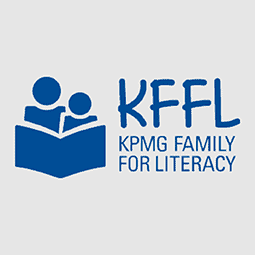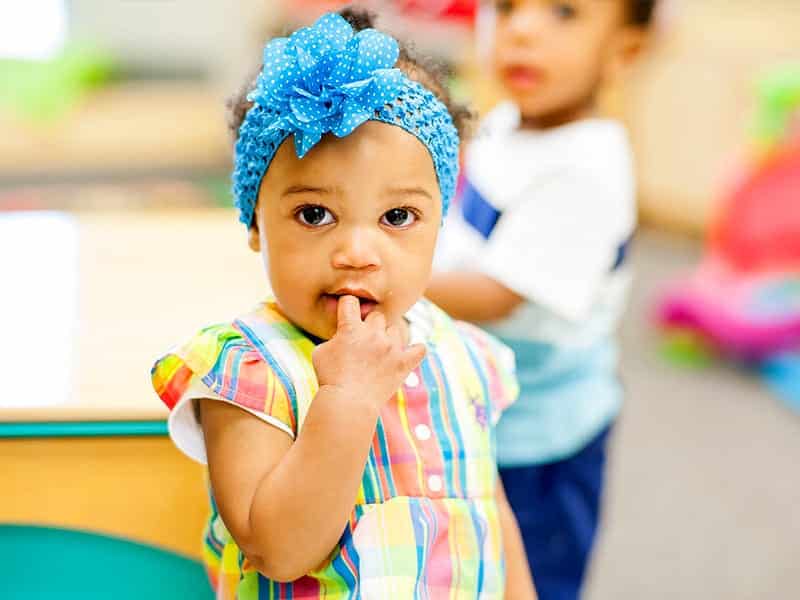Don’t underestimate the incredible thinking skills that young children have. Through this activity, your toddler will learn about the idea of perspective by using everyday objects and comparing their sizes.
Stay Connected
Sign up to receive news, helpful tools and learn about how you can help our youngest learners.
Materials Needed:
- Paper (can be a newspaper, magazines, paper bags, notebook paper, etc.)
- A pencil or other writing tool
- Tape (optional)
Developmental Goals:
- Understand the idea of larger and smaller.
- Increase the use of mathematical vocabulary such as larger than or smaller than.
- Support understanding of ordering objects by size (smallest to largest or largest to smallest).
In the Future:
- The ability to order objects by size will build the foundation for the understanding that numbers represent different amounts.
- Your toddler’s ability to compare two or more objects by size will build prior knowledge that will allow her to compare two or more objects by other factors (color, texture, speed, weight, etc) that will be useful in further math and science understanding.
- Understanding the concepts of bigger and smaller is a foundation skill for eventually understanding fractions and parts of a whole.
At-Home Activity:
- With your toddler, trace their hand (or foot). Also trace your hand and the hands (or feet) of any other family members, neighbors, or caregivers.
- Either tape the traced hands (feet) on the wall or lay them on the floor. Do so randomly at first.
- Ask your child to find a handprint that is the same size as theirs. Challenge them by asking, “I wonder if you can find a print that is larger/smaller than yours?” You can also ask them to choose a print that they think may be the same size/larger/smaller than yours or other members of the household.
- When your toddler is finished exploring the sizes of the prints, challenge them to line the prints up from smallest to largest or from biggest to smallest. As they do so, guide them by asking “I wonder how we can decide which print to start with?” or “I wonder which print should come next?” As your child works, don’t correct any “mistakes.” Rather, when they’re is finished, look at the order with them and ask if the prints look as though they are lined up from smallest to biggest. Encourage your child to compare each print to observe the different sizes.
More Like This
From a child’s first soccer team to recreational softball leagues to rooting for your favorite team, sports hold an iconic place in our lives. And they play an equally important role in helping children’s development in the early years.
It’s easy to see how sports can help with children’s gross and fine motor skills development. Less obvious, but just as critical, is the role that sports and play-based learning activities have in social-emotional development and speech and language development.
Be a Good Sport
As babies grow into toddlers, they gradually start to regulate their emotions. Playing sports with others gives them the opportunity to experience feelings such as joy, frustration, pride and patience in a non-threatening situation. To help them develop social-emotional skills, try:
- Naming emotions as they play. “Suzy, great job catching that ball – you must be so proud of yourself!”
- Help your child regulate his emotions when he is upset by talking about their feelings. “Tyler, I can see that you’re upset about missing the goal – let’s talk about why you’re upset.”
As children continue to grow and begin to play on teams, they develop teamwork skills that will be invaluable on and off the field. Team sports also provide a great opportunity to encourage empathy while learning new skills and celebrating successes. Try these tips to make sure your child will win the sportsmanship award:
- Model the behavior you want to see – cheer as loudly for all the children on the team as you do for your child. Encourage your child to be a “cheerleader” for their team.
- Reinforce the importance of taking turns at shooting the basket or practicing on the balance beam.
Hat Tricks, Fartleks and Setter
Every sport comes with a vocabulary of its own. Which means more and more opportunities to expose your children to new and varied language! From silly to repetitious to obscure, how do you make the most of this treasure trove?
- As your child plays, name actions and items that are involved in their sport. Kick, run, pass, racquet, ball, tee, somersault…..the list is endless.
- Have your child put the game into their own words – ask them to tell you how the game works.
We can’t guarantee that your child will become the next Serena Williams, David Beckham, Simone Biles or Derek Jeter, but we do know that time spent playing sports in the early years will pay off in many other ways!
Recommended for Infants
Materials Needed:
- Several small, interesting toys (rattles, teethers, colorful blocks, shakers)
- Soft blanket
Developmental Goals:
- Promote gross and fine motor development that encourages them to move, reach and stretch.
- Purposeful movement of own bodies.
In the Future:
- Infants need plenty of opportunities to increase their strength and motor development to eventually be able to crawl and then walk.
- Reaching for objects is goal directed behavior; as infants become successful at obtaining objects, it will encourage them to continue to act with purpose.
Activity:
- This activity is appropriate only for infants who are able to support their body weight enough for tummy-time activities.
- Spread the blanket on the floor in an area where he will be protected from other activity in the room.
- Place him on his tummy on the blanket. Show him a toy and describe it to him. Look, (Child’s Name), I have a blue and white rattle.
- Put the toy on the blanket just at arm’s reach from your child so that he has to stretch his arm out to grab it.
- Give him time to shake, mouth and touch the toy.
- When he shows you he is ready for a new experience, place another toy just at arm’s reach for him to grab.
- Encourage him to use the opposite arm by placing the toy within closer reach of the arm he did not previously use.
- Repeat the interaction for as long as your child is interested. Pay particular attention to his activity level. It is hard work for your child to lie on his tummy and reach for toys. You may notice that he is beginning to have a hard time supporting his head and neck, he is no longer reaching for objects, or he has an unhappy look on his face. When your child shows you that he is finished or that his body is getting tired, help him change position so he can rest his muscles.
As you are playing with your baby, consider how he moves his arms and the rest of his body to reach the toy, in what ways does he grasp and manipulate the toy, and how long is he able to attend to his experience.
Don’t underestimate the incredible thinking skills that young children have. Through this activity, your toddler will compare objects and ask questions to help understand their differences in quantity.
Stay Connected
Sign up to receive news, helpful tools and learn about how you can help our youngest learners.
Materials Needed:
- Two small bowls or boxes of the same size
- Small objects found around the house (hair barrettes, legos, crayons, buttons, keys, coins, toothpicks, clothespins, bracelets, etc.)
Developmental Goals:
- Encourage curiosity and problem solving
- Promote the understanding of more or less in terms of quantity
- Assist in the use of mathematical vocabulary such as more, less, greater than, less than, larger, smaller and same
In the Future:
- The process of making informed guesses about what will happen is a key piece to the process of science that children will need throughout their school life.
- By first understanding the concept of more or less, children are building prior knowledge for the understanding of volume and conservation (that objects don’t change in volume when transferred from one container to another).
Activity:
There are two ways to think about more or less, either looking at objects or containers. For toddlers, it’s best to start with object comparison. Think about the items and ask which container has more or fewer items than the other container?
Thinking About the Objects:
- Give your toddler two containers that are the same size.
- Ask them to pour some of the chosen objects into one container and some into the other.
- Ask them which container they think has more (or fewer) objects?
- As you are playing, encourage your child to investigate by asking, “I wonder if there is another way we can decide which container has more buttons?”
- They can then come up with a strategy on their own, such as lining both sets of objects up, counting each set of objects or stacking each object.
Be sure to keep it fun and act as investigators. There is no need for a “right” answer at this stage. What’s more important is that your toddler is beginning to understand that not all amounts are the same.
More Like This
Recommended for Preschoolers
Materials Needed:
- Not a Box by Antoinette Portis
- Cardboard boxes, cardboard tubes, other recycled materials
- Bedsheets or blankets
Developmental Goals:
- Using language to share ideas.
- Using imagination in play.
In the Future:
- Being able to express ideas through language gives young children the opportunity to strengthen their vocabulary and develop their conversational skills.
- Imaginative thinking provides children with opportunities to develop flexible thinking, strengthening their ability to problem solve, which is important when attempting later math and reading problems.
Activity:
- Introduce the book to your child. As with any new book, take time to allow your child to explore the book’s pictures on his own before sitting down to read it out loud.
- As you read the book together, invite him to talk about the different things that the rabbit makes with his cardboard box.
- After reading the story, show your child the recycled materials you have collected. Working together, decide what you will build.
- Allow your child to take the lead, but don’t be afraid to join in and share ideas!
- After the play space is built, ask him to describe what he built.
For older preschoolers: have them use writing tools to record a blue print of what they want to build prior to building. This provides them with the opportunity to analyze, plan and follow through on their ideas.
More Like This
While much attention and effort has been directed at addressing the widening opportunity gap in the United States, children growing up in communities that are under-resourced from decades of historical and institutional racism face an equally pervasive and related health gap. By and large, they have markedly worse health than their peers from more advantaged communities. This gap appears early in life and builds over time. Science suggests that adverse early life experiences and environments — prenatally and in a child’s first years — can contribute to the health gap, leaving biological imprints on the child’s developing body and brain that can have strong and lasting effects.
Fortunately, new and current research points us to a critical strategy in narrowing the health gap and giving all children a chance at good health over their lifetime: We can ensure that every child has access to high-quality early childhood programs, including early education and home visiting.

Start Early to Support Social & Emotional Health
Our research team translates research and studies strategies and interventions that target social and emotional skills and development.
Attachment ─ the security, confidence, and trust that infants and toddlers have with the adults responsible for their care ─ is the framework within which babies develop their growing ability to regulate emotions and behavior. Babies thrive when they are securely attached to their mother, father or primary caregiver who knows and responds consistently and reliably to their unique personalities. Infants and toddlers who are not securely attached are likely to become preschoolers who are unable to control their behaviors and kindergartners who have difficulty engaging in the process of learning.
Recognizing the importance of secure attachment, Start Early implements a continuity of care model in partnership with our network of early learning schools, the Educare Learning Network. This model minimizes the disruptions that children experience by keeping infants and toddlers with the same classroom team of teachers until they transition to preschool.
Secure Attachment
Learn more about the research behind secure attachment and continuity of care.
Young children who lack at least one loving and consistent caregiver in the earliest years may suffer severe and long-lasting development problems. This landmark study of scientific brain research shows environmental stress, even among infants and toddlers, can interfere with the proper development of neural connections inside the brain essential to a child’s proper social and emotional development. This report recommends that early childhood programs balance their focus on literacy and numerical skills with comparable attention to the emotional and social development of all children.
From Neurons to Neighborhoods: The Science of Early Childhood Development was published in 2000 by the National Research Council and Institute of Medicine of the National Academy of Sciences.
How parents and caregivers speak to children significantly affects their I.Q., literacy, and academic success later in life, according to University of Kansas child psychologists Betty Hart and Todd Risley.
Hart and Risley found that the number of words and encouragements and the breadth of vocabulary heard by a child during the first three years of life can dramatically affect language development and I.Q. Their study was informed by close observations of 42 1- and 2-year olds and their families for more than two years.
From those observations, the researchers estimated children in professional families hear approximately 11 million words per year; while children in working class families hear approximately 6 million, and children in families receiving public assistance hear approximately 3 million words annually.
For more information on the study, read: Hart, B. & Risley, T.R. (1995). Meaningful Differences in the Everyday Experience of Young American Children.

This Giving Tuesday, we partnered with KPMG’s Family for Literacy program who matched funds raised during the day with $10,000 worth of books for children at 26 early childhood programs. We are so grateful to have such a dedicated partner like KPMG who believe in our mission to ensure our earliest learners have the best start in school and life.
Recently, we sat down with Kerri Neis, associate director at KPMG, to discuss why fighting illiteracy and supporting Start Early is important to the company.
- Why are literacy and early education essential parts of KPMG’s Corporate Citizenship initiatives?
KPMG’s Citizenship efforts are centered on lifelong learning, which is essential to unlocking the potential in people, building economies, and above all, improving lives. Literacy is at the foundation of lifelong learning, and access to books is necessary to build strong reading skills. Specifically, the need is profound in Chicago. We know that by fourth grade, only about 27 percent of Chicago’s students are considered proficient in reading–there is a literacy crisis we can’t ignore. And in Chicago’s low-income neighborhoods, there is only one book for every 300 children, whereas in middle-class neighborhoods, there are 13 books per child on average. The statistics are so motivating for all of our leaders, partners, and employees—who have enjoyed an education and want to give back to the communities they love. - What is KPMG’s Family for Literacy (KFFL) program?
KFFL is the firm’s flagship Citizenship program with a mission to eradicate childhood illiteracy by putting new books into the hands of children in need and developing the next generation of young leaders through reading. This unique program is particularly effective because it harnesses the energy and enthusiasm of KPMG’s extended family—not only partners and employees, but also spouses, children, interns, retirees, alumni, professional golfers, and KPMG Brand Ambassadors Phil Mickelson, Stacy Lewis, Mariah Stackhouse, Maverick McNealy and Olympic gold medalist Laurie Hernandez.Since its inception in 2008, KFFL has distributed over 5 million new books to low-income children in 100+ communities across the United States. KFFL also translates across borders having spread through KPMG’s global network to India, Mexico, South Africa, Zambia, the U.K., Kenya, Canada and China.
- How does partnering with an organization like Start Early help KFFL support its mission of eradicating childhood illiteracy?
Our organization and networks allow us to raise the funds to buy books, source volunteers to pack and deliver books, visit schools and libraries, and fuel the enthusiasm to share the importance of our mission. But we count on partners in the community to connect us with the right communities in the right way, which allows us to bring the books into the communities we most want to serve. Our core competencies lie in providing Advisory, Tax, and Audit services to our clients—our KFFL partners’ core competencies lie in serving constituents in communities. Those partnerships are so valuable to us as they provide the network, trust, and connectivity to carry out our mission.We have been so impressed with the holistic and critical services Start Early provides to their communities, that is why we were thrilled to be able to provide books to the schools, children, and families in their network. We hope that in addition to literacy skills, these books bring families together for quality time, spark the imaginations of young readers, and inspires their children to learn more. Because that is what we are all about at KPMG—lifelong learning!

